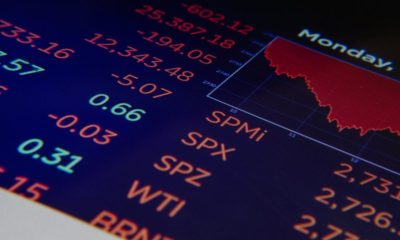Business
Powell the Pivoter Cannot Now Pivot Back to a Dove
While Powell may desire to pivot back to a Dove as the stock market and economic data begins to falter, he cannot easily do so…not while inflation has risen to a forty-year high. During the previous round of QT, inflation was below the Fed’s 2% target. Powell no longer has the luxury to claim inflation is quiescent. Also, the Fed’s balance sheet has doubled since the first QT program.

The current Fed Chair is perhaps best known for his quick pivots from hawkish back to dovish and vice versa. Maybe he is just too dependent on the prevailing winds of the current economic data. Or, perhaps more accurately, he is most swayed by the performance of the stock market. In either case, Jerome Powell received more reasons to become hawkish just one day following his already hawkish FOMC press conference.
The Bureau of Economic Analysis reported Q4 2021 GDP growth at a 6.9% SAAR. This is a big problem for the Fed, since it falsely believes inflation comes from an economy that is growing too fast. Add in the 7% CPI print for December, and you have a Fed that now understands it is far behind the inflation curve and it’s time to pivot towards an even tighter monetary policy stance. Nevertheless, the FOMC fails to grasp the rapid growth and inflation was engendered by unprecedented fiscal and monetary stimulus, which has now gone in reverse.
Hence, what you have in reality is a massive fiscal and monetary drag that is already set to drive GDP growth towards the flat line. And, when you factor in the inventory build, which added 4.9 percentage points to the GDP figure in Q4, you get a slowdown this year that will be profound. But despite this organic slowing of the economy, inflation will be much more reluctant to become tractable. Rising energy prices, higher wages, and surging Owner’s Equivalent Rent values should keep CPI well above the Fed’s 2% target throughout most of 2022. Indeed, average rents rose 14% last year to $1,877 a month. In certain cities like New York and Miami, the yearly surge increased by as much as 40%, according to data from real estate firm Redfin.
Also pushing Powell along with his tighter monetary policy stance will be the data on inflation-adjusted incomes. Real disposable personal income decreased by 5.8% in the fourth quarter of last year.
What this all means is the dithering Fed will now be forced to catch up with the process of raising interest rates off the zero bound range and start draining its $9 trillion balance sheet. But this tighter monetary policy will occur in the context of an economy that is already slowing down. The Atlanta Fed estimates Q1 GDP growth at just 0.1%. Members of the FOMC have made it clear that they will look right past the first quarter weakness because of the Omicron variant’s negative effect.
The rapid drop in GDP growth, alongside the continuing headwinds of fiscal and monetary drags, should ensure that any stock market rally enjoyed in the remainder of Q1–following the January drubbing of equities–should be short-lived. Powell has well-telegraphed that the liftoff from the zero bound range will happen in March. And, unless inflation surges higher from the current 7% level between now and then, that first rate hike will be just 25 bps, not the feared 50 bps. Wall Street is prepared for that gentle liftoff and should be able to sustain the mild blow.
Nevertheless, by the end of the second quarter, the full impact from the monetary meltdown should begin to be felt. During May and June, the second and third interest rate hikes should take place. Also, in June, the FOMC will lay out its plan for the commencement of draining its massive $9 trillion balance sheet (QT) and also layout the pace of its decline. We can derive some clues about the Fed’s second QT operation by analyzing the statements made by the Fed Chair during his last press conference.
There are two salient quotes from Mr. Powell’s press conference. Regarding rate hikes, the Fed Chair stated, given the strength of the labor market and economy, “I think there’s quite a bit of room to raise interest rates without threatening the labor market.” The second and perhaps more important statement from the Fed-head was made in response to a question about the pace and timing of the Quantitative Tightening program. Powell said, “The balance sheet is much bigger and [its composition] has a shorter duration. And the economy is much stronger, and inflation is much higher. So, that leads you to being willing to move sooner than we did the last time and also perhaps faster.”
By how much should we expect the Fed to reduce its balance sheet? Well, Powell didn’t put an exact number on how much will be shed. But he did say he will “Significantly reduce the size of the balance sheet.” He also said he wants the Fed’s asset holdings to be limited to Treasuries. This means Powell will need to dump all of the $2.7 trillion of Mortgage-Backed Securities it currently holds on the market in relatively short order. That could spell disaster for the real estate market, which is the most overvalued in history based on the home price to income ratio, and was built on the back of record-low mortgage rates.
The Fed again had the temerity to try and claim this upcoming QT regime would simply run innocuously in the background—just like they claimed the last one would before stocks plunged and the REPO market froze. Previous Fed Chairs claimed that QT would be so uneventful it would be like watching paint dry. Let’s see just how true that is. The first time the Fed began draining its balance sheet was in October of 2017. The initial pace of asset reduction was $6 billion of Treasuries and $4 billion MBS. But by 2018, that pace increased to $30 billion in Treasuries and $15 billion in MBS. However, the stock market began to revolt by the fall of that same year. This prompted the Fed to announce in March of 2019 that it would cut in half the rate of asset sales starting in May and would cease QT entirely by September. As it turned out, the Fed had to completely end QT even earlier than indicated due to the 30% plunge in the Russell 2000 and the complete dysfunction in credit markets.

What all this means is that while Powell may desire to pivot back to a Dove as the stock market and economic data begins to falter, he cannot easily do so…not while inflation has risen to a forty-year high. During the previous round of QT, inflation was below the Fed’s 2% target. Powell no longer has the luxury to claim inflation is quiescent. Also, the Fed’s balance sheet has doubled since the first QT program. That is why the upcoming iteration of QT will likely run at twice the $45 billion per month pace seen when the first failed attempt to reduce the balance sheet began.
Of course, the Fed will eventually pivot back to Quantitative Easing to rescue the markets. But that will most likely be after the credit markets freeze and/or the major averages plunge greater than 30%. Until then, the Fed must continue to fight the battle against all-time, record-high inflation. Jerome Powell’s calculation is easy: defending the portfolios of the wealthiest Americans cannot take precedence over continuing to destroy the purchasing power and living standards of the voting middle class.
__
(Featured image by AbsolutVision via Pixabay)
DISCLAIMER: This article was written by a third-party contributor and does not reflect the opinion of Born2Invest, its management, staff, or its associates. Please review our disclaimer for more information.
This article may include forward-looking statements. These forward-looking statements generally are identified by the words “believe,” “project,” “estimate,” “become,” “plan,” “will,” and similar expressions. These forward-looking statements involve known and unknown risks as well as uncertainties, including those discussed in the following cautionary statements and elsewhere in this article and on this site. Although the Company may believe that its expectations are based on reasonable assumptions, the actual results that the Company may achieve may differ materially from any forward-looking statements, which reflect the opinions of the management of the Company only as of the date hereof. Additionally, please make sure to read these important disclosures.

-

 Fintech1 week ago
Fintech1 week agoPayPal Under Fire: Excessive Data Collection and Privacy Concerns in Advertising
-

 Africa4 days ago
Africa4 days agoMorocco’s Rising Country Risk Profile Boosts Investor Confidence
-

 Cannabis2 weeks ago
Cannabis2 weeks agoTrump Signals Historic Shift: U.S. Weighs Reclassifying Cannabis from Schedule I to III
-

 Crypto1 week ago
Crypto1 week agoHyperliquid Proposes Burning $1B in HYPE to Make Supply Deflationary

























